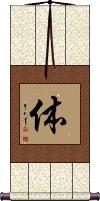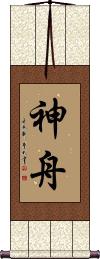Many custom options...
And formats...

Vessel in Chinese / Japanese...
Buy a Vessel calligraphy wall scroll here!
Personalize your custom “Vessel” project by clicking the button next to your favorite “Vessel” title below...
Taido
Taidō (The Way of the Body) is a style of Karate practiced in Japan and popular worldwide.
Taidō or 躰道 traces a lineage from Genseiryū (玄制流), which came from Shuri-te (首里手), one of the original martial arts schools of ancient Okinawa.
The first character 躰 is a variant of the original Chinese character 體. In modern Japan, they tend to use 体, a more simple character form. 体 is also the modern Simplified Chinese form of 體.
The 躰 character is correct for this 躰道 martial arts title. But it can be confusing with so many variants out there, not to mention other homophonic Japanese words that also romanize as Taidō or Taidou.
To have a bit more fun with this 躰 character, it has a 身 radical on the left, which sets it apart. The meaning doubles up on the “body” as 身 (shin) is a character that also means body in Japanese and Chinese. On the right is 本, which often means root, stem, origin, source, or fundamental (but can also mean “book” in some contexts). This has deviated from the original 體 which was 骨 (bone) + 豊 (vessel). Hence, the body was your “bone vessel” in ancient Asia.
The meaning of 躰, as well as 體 and 体, is usually translated as the body. When related to the physical body, it can also refer to the torso, trunk, build, physique, or the constitution of a person. As an extension of this, it can also refer to someone's health (good body = good health).
However, depending on the context, it can encompass other meanings such as form, style, system, experience, aspect, corpus, corporeal, substance, or essentials.
The second character, 道, is recognized and well-known as the “Way” and is the same “do” as in Karate-do or Aikido.
Body / Karada
体 is used in Japanese to mean “body.”
体 can also refer to the form, style, corporeal existence, appearance, identity, or state of something or someone. 體 is also used in Buddhism in regard to the corporeal existence of someone (their earthy vessel). It's kind of a broad term that can be used in a lot of different ways.
As a single character, it's usually pronounced “karada” but it can also be pronounced “tai” or “te” (Japanese pronunciation borrowed from the original Chinese).
體 is not a common Kanji to use for a wall scroll. Only select this if you have a personal and meaningful reason to do so. Also, consider this version to be “Japanese only” - see below...
![]() In Chinese and old Korean Hanja, this character is written in the traditional form shown to the right. If you want this version, click on the character to the right instead of the button above.
In Chinese and old Korean Hanja, this character is written in the traditional form shown to the right. If you want this version, click on the character to the right instead of the button above.
Shenzhou Spacecraft
神舟 is the name of the Chinese spacecraft “Shenzhou.” The name means “divine craft” or “saintly vessel.”
The name is a play on words in Chinese, as there is an alternate name for China that is pronounced “Shenzhou” but means “Divine land” or “Land of the Gods” (just the second character is different).
The first flight of a Shenzhou spacecraft was in 1999, with more missions following. The next is planned for 2008, and will include China's first “spacewalk.” The tenth Shenzhou mission is planned for 2015, when China has promised its people that a Chinese astronaut will walk on the moon (or at least orbit the moon - there are two ways to interpret the announcement made in 2005).
For those of you concerned, this word is pronounced more like “Shen Joe” (with a slightly soft “J”) than the Romanization would suggest.
2016 Update: I wrote the above in 2006. Imagine that, 10 years later, none of the promises came true.
Not the results for vessel that you were looking for?
Below are some entries from our dictionary that may match your vessel search...
| Characters If shown, 2nd row is Simp. Chinese |
Pronunciation Romanization |
Simple Dictionary Definition |
盧 卢 see styles |
lú lu2 lu rou / ro ろう |
More info & calligraphy: Luu(surname) Rou A rice-vessel; a fire-pan; dram-shop; black; translit. lo, ro, ru; cf. 樓; 路; 流. |
カッブ see styles |
kabbu カッブ |
(See コップ・1) cup (drinking vessel, measure, brassiere, prize, etc.); (surname) Cobb |
器 see styles |
qì qi4 ch`i chi utsuwa うつわ |
device; tool; utensil; CL:臺|台[tai2] (n,n-suf) (1) device; instrument; (n,n-suf) (2) vessel; container; (3) ability; capacity; calibre; caliber; (given name) Utsuwa A vessel, utensil, tool. |
壷 see styles |
tsubosaki つぼさき |
(out-dated or obsolete kana usage) (1) jar; pot; vase; (2) dice cup; (3) depression (i.e. the basin of a waterfall); (4) (archaism) target (when aiming an arrow); (5) (kana only) (figurative) bull's-eye; (6) (kana only) key point (of a conversation, etc.); (7) (kana only) acupuncture point; moxibustion point; (8) (kana only) nodes on a fingerboard (of a shamisen, etc.); hu (ancient Chinese vessel shaped like a vase, usually used to store alcohol); (surname) Tsubosaki |
壺 壶 see styles |
hú hu2 hu tsubosaki つぼさき |
pot; classifier for bottled liquid (out-dated or obsolete kana usage) (1) jar; pot; vase; (2) dice cup; (3) depression (i.e. the basin of a waterfall); (4) (archaism) target (when aiming an arrow); (5) (kana only) (figurative) bull's-eye; (6) (kana only) key point (of a conversation, etc.); (7) (kana only) acupuncture point; moxibustion point; (8) (kana only) nodes on a fingerboard (of a shamisen, etc.); hu (ancient Chinese vessel shaped like a vase, usually used to store alcohol); (surname) Tsubosaki |
尊 see styles |
zūn zun1 tsun mikoto みこと |
senior; of a senior generation; to honor; to respect; honorific; classifier for cannons and statues; ancient wine vessel (1) zun (ancient Chinese wine vessel, usu. made of bronze); (prefix) (2) (archaism) (honorific or respectful language) honorific prefix referring to the listener; (suf,ctr) (3) counter for buddhas; (female given name) Mikoto To honour. ārya; honoured, honourable. |
嶡 see styles |
jué jue2 chüeh |
sacrificial vessel |
彝 see styles |
yí yi2 i tsune つね |
(archaic) wine vessel; (archaic) sacrificial vessel; (literary) rule; convention (given name) Tsune |
彞 彝 see styles |
yí yi2 i |
ancient wine vessel; ancient sacrificial vessel; Yi ethnic group; normal nature of man; laws and rules See: 彝 |
斛 see styles |
hú hu2 hu teruo てるお |
ancient measuring vessel; fifty liters; dry measure for grain equal to five dou 五斗 (before Tang, ten pecks) (1) measure of volume (approx. 180.39 liters, 6.37 cub. ft.); (2) measure of a Japanese-style boat's loading capacity (approx. 278.26 liters); (personal name) Teruo droṇa, a tub, or wooden vessel; a measure of capacity. A square wooden vessel, a bushel, a picul. |
斠 see styles |
jiào jiao4 chiao |
(old) instrument to even out the grain in a measuring vessel; to proofread; to collate |
燜 焖 see styles |
mèn men4 men |
to cook in a covered vessel; to casserole; to stew |
牟 see styles |
móu mou2 mou mu む |
barley; to moo; to seek or obtain; old variant of 侔[mou2]; old variant of 眸[mou2] (surname) Mu To low (as an ox); overpass; barley; a grain vessel; weevil; eye-pupil; translit. mu, ma. |
璉 琏 see styles |
liǎn lian3 lien |
sacrificial vessel used for grain offerings; also pr. [lian2] |
瓮 see styles |
wèng weng4 weng motai もたい he へ |
variant of 甕|瓮[weng4]; earthen jar; urn (archaism) earthenware vessel for alcoholic beverages, etc. |
甌 瓯 see styles |
ōu ou1 ou |
(pottery) bowl or drinking vessel |
甕 瓮 see styles |
wèng weng4 weng you / yo よう |
pottery container for water, wine etc (archaism) fired earthenware vessel used by the emperor to clean his hands; (surname) Yō kumbha, a pitcher, jar, pot. |
甗 see styles |
yǎn yan3 yen |
earthenware vessel |
皿 see styles |
mǐn min3 min sara さら |
(bound form) dish; vessel; shallow container; radical no. 108 (1) plate; dish; platter; disc; (n,n-suf,ctr) (2) serving; helping; course; (3) kanji radical 108 (at the bottom); (place-name) Sara |
盉 see styles |
hé he2 ho |
vessel similar to a kettle, but with three or four legs, used in ancient times for warming wine |
盡 尽 see styles |
jìn jin4 chin tsukusu つくす |
to use up; to exhaust; to end; to finish; to the utmost; exhausted; finished; to the limit (of something); all; entirely (male given name) Tsukusu An emptied vessel, all used up; end, finish, complete, nothing left; all, utmost, entirely. At the end of seven days, seven days being completed. |
簋 see styles |
guǐ gui3 kuei |
ancient bronze food vessel with a round mouth and two or four handles; round basket of bamboo |
缶 see styles |
fǒu fou3 fou hotogi ほとぎ |
pottery (1) fat-bodied, small-mouthed earthenware jar for carrying water; (2) water vessel used for a baby's first bath; (surname) Hotogi |
舟 see styles |
zhōu zhou1 chou fune ふね |
boat (1) ship; boat; watercraft; vessel; steamship; (2) tank; tub; vat; trough; (n-suf,ctr) (3) counter for boat-shaped containers (e.g. of sashimi); (surname, female given name) Fune boat |
船 see styles |
chuán chuan2 ch`uan chuan fune ふね |
boat; vessel; ship; CL:條|条[tiao2],艘[sou1],隻|只[zhi1] (suffix noun) ship; boat; vessel; (surname, female given name) Fune A boat, ship. |
艇 see styles |
tǐng ting3 t`ing ting tei / te てい |
vessel; small ship (small) boat |
艜 see styles |
dài dai4 tai |
a long narrow vessel with two masts |
角 see styles |
jué jue2 chüeh tsumo つも |
role (theater); to compete; ancient three legged wine vessel; third note of pentatonic scale (1) horn; antler; (2) antenna; feeler; tentacle (e.g. of a snail); (3) horn-like projection (e.g. peaks of whipped cream); (surname) Tsumo viṣāna ; a horn, a trumpet: also a corner, an angle; to contend. |
觳 see styles |
hú hu2 hu |
ancient measuring vessel (same as 斛); frightened |
豊 see styles |
lǐ li3 li yutaka ゆたか |
ceremonial vessel; variant of 禮|礼[li3] (surname, female given name) Yutaka |
Click here for more vessel results from our dictionary
The following table may be helpful for those studying Chinese or Japanese...
| Title | Characters | Romaji (Romanized Japanese) | Various forms of Romanized Chinese | |
| Taido | 躰道 | tai dou / taidou / tai do | ||
| Body Karada | 體 体 | karada / tai / te | tǐ / ti3 / ti | t`i / ti |
| Shenzhou Spacecraft | 神舟 | shén zhōu shen2 zhou1 shen zhou shenzhou | shen chou shenchou |
|
| In some entries above you will see that characters have different versions above and below a line. In these cases, the characters above the line are Traditional Chinese, while the ones below are Simplified Chinese. | ||||
Successful Chinese Character and Japanese Kanji calligraphy searches within the last few hours...






